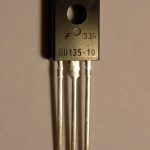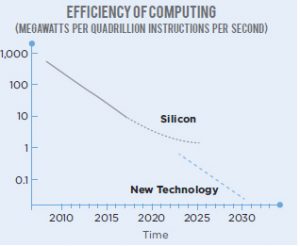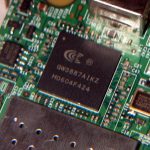Wait. What do you mean ‘transistors’?
Yep, ‘transistors’ are still the basis of electronics.
In essence, they’re the tiny controllable switches that form the building blocks of logic circuits, switching between open (0) and closed (1).

The familiar three-legged transistors of old are now only micro-metres in size
In your Dad’s old ‘wireless’ radio, transistors were the small metallic components shaped like War of the Worlds war tripods. Those replaced the glass tubes of Grandpa’s old valve radio.
These days, transistors are tiny: only a few micrometres across – around the size of a large virus. The average smartphone now has one or two billion transistors packed into its controlling microchip.
But whether transistors are big glass valves, small metal components, or microscopically small, they still perform the same function: voltage across a channel can be controlled by a gate electrode, switched between off (0) and on (1) to provide a logic function. Enough logic functions in the right order, and you have a smartphone, a desktop PC, weather forecasting, Netflix, or LOLcats.
So how have we got to the point where a billion transistors now fit on a tiny microchip?
Over the last 50 years, transistors have got smaller and smaller, and smaller, and smaller – a phenomenon dubbed ‘Moore’s Law’ whereby the numbers of ‘switches’ (transistors) per unit area has doubled every 18 months. The ‘Law’ was first proposed by Intel co-founder Gordon Moore way back in 1965, and has proved remarkably consistent ever since.

Microchips have become more and more power efficient with time, but future improvements are limited unless we switch from silicon to another technology
Moore’s Law fast became an accepted statement of fact in the computing industry, and has been haphazardly applied to related tendencies for similarly exponential improvements in computing power and energy efficiency.
At FLEET, our interest in Moore’s Law centres on related issues regarding energy efficiency.
As improvements in size flatten out, so have improvements in energy.
And with the demand for more and more computation every year, now, the energy used in computation has reaching something like 5% of global electricity use, and that’s doubling each decade.
And we want more. We want cars and trucks that will drive themselves, safely and efficiently. We want an ‘Internet of Things’ where every device in our house speaks to every other device. We want on-demand voice recognition and translation.
But for computing to continue to grow, we must control ICT’s energy requirements. We need a new, ultra-low energy alternative. We need transistors that can switch without burning energy.

A smartphone microchip can have one or two billion transistors, each around the size of a virus
Ultra-low energy electronics are pursued at FLEET, using new fields of physics to create a generation of electronics in which transistors can switch with zero, or near-zero dissipation of energy.
Such electronics would be based upon atomically-thin materials: materials that are just one layer of atoms in thickness (similar to graphene, which is a single, two-dimensional sheet of carbon atoms).
In traditional, silicon-based electronics, energy is dissipated as electrons scatter off impurities and the semiconductor lattice. FLEET will use the relatively new science of topological materials to create transistors with no scattering, and thus zero, or near-zero, wasted dissipation of energy.
Topological insulators, which were recognised by the 2016 Nobel Prize in Physics, are 2D materials that are electronically insulating through the centre, but can carry a one-dimensional flow of electrons along their edges. Because that path is one-dimensional, electrons cannot scatter, and do not burn energy.
In a recent research project at Monash University, FLEET researchers successfully ‘switched’ a topological material’s conduction mode for the first time, the precursor to topological transistors.
FLEET will also use a quantum state known as a ‘superfluid’, in which charged particles ‘flow’ with zero electrical resistance. Exciton transistors will switch off and on just like conventional transistors, but without dissipating energy.
In each case, for the new technology to form a viable alternative to traditional transistors, the desired properties must be achievable at room temperature. There’s no point in saving energy on transistor switching if you have to use even more energy to keep the system super-cold.
Both fields are new, cutting-edge physics. FLEET is also charged with making fundamental, curiosity-driven discoveries that will support the development of new electronics, but also advance the field of physics significantly.
FLEET will develop new ultra-low energy electronics that will allow computing to continue to grow and put Australia at the forefront of the new technology, and train a workforce for future industry.
For more information

